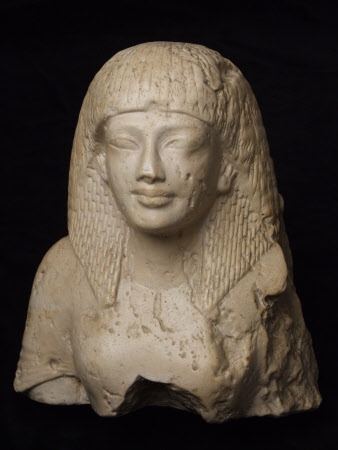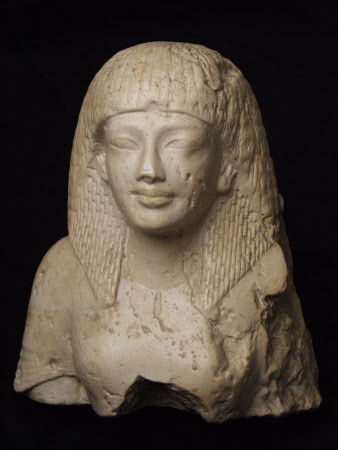Plaster copy of the bust of an Egyptian high status male official or male scribe
Category
Art / Sculpture
Date
circa 1905
Materials
Plaster
Measurements
300 x 260 x 150 mm
Order this imageCollection
Shaw's Corner, Hertfordshire
NT 1275316
Summary
Plaster bust of an Egyptian male scribe or high status official, a cast after a New Kingdom, late 18th Dynasty hard limestone bust of a man, 1400-1300 BC, Birmingham Museum and Art Gallery. Previously thought to be of a woman, or a representation of the goddess Isis, it is now firmly believed to be of a man. He wears a male duplex wig, the top and back of the wig have wavy strands of hair tied into ringlets at the ends, and these are superimposed over a second wig, entirely composed of ringlets which fall over the shoulders. The bust shows the ravages of time, areas of soft rock within the limestone have weathered away to produce a pitted appearance. The bust would have been highly polished and originally painted. On the reverse hieroglyphics are inscribed.
Full description
The plaster copy of the bust of an Egyptian male scribe or high status official, sitting on the mantelpiece, was acquired by Bernard and Charlotte Shaw in the early 1900s as a result of their friendship with Sir Whitworth Wallis (1855-1927), who was the first director of Birmingham Museum and Art Gallery from 1885. A postcard in the Shaw’s Corner collection from Wallis to Bernard Shaw has an image of the bust one side, with Wallis’s message on the other. The original ‘Limestone New Kingdom Bust’ (late 18th Dynasty, 1400-1300 BC) is in the Birmingham Museum and Art Gallery, and had been presented to Wallis by a Miss Hanson in 1896. Wallis then donated it to the Museum, and it was copied at the suggestion of the Birmingham-based music critic Ernest Newman who was well known to Shaw. Newman was the music critic of The Birmingham Post, and wrote studies of three of Shaw’s favourite composers: Richard Wagner (1914), Edward Elgar (1906), and Richard Strauss (1908). Several plaster copies after the original sculpture were made in the early twentieth century, of which the Shaws’ bust is one. The journalist H.V. Morton wrote an article on the bust published in May 1914 in The Connoisseur magazine where he incorrectly described it as a ‘marble bust of the goddess Isis’. (H.V. Morton, ‘The “Mona Lisa” of Ancient Egypt’, The Connoisseur: A Magazine for Collectors, 39, 153, May 1914, p.27). It hence became renowned as the ‘Mona Lisa of Ancient Egypt’ and ‘The Birmingham Isis’, however today it is generally accepted as a representation of a male scribe or high status male official c.1310 BC, wearing the typically elaborated ‘double-style’ wig fashionable at the time. (Martin Ellis et al, eds., World Art: from Birmingham Museums and Art Gallery, 1999, p.38). We know that the Shaws’ copy was acquired before 1908, as it appears on the Adelphi Terrace Inventory (which lists the contents of their London flat) although it is unclear when it was brought to Shaw’s Corner. The bust should be seen as part of Bernard Shaw’s long-standing interest in the visual culture of Ancient Egypt. Shaw drew upon that culture when he wrote his play Caesar and Cleopatra in 1898, including the mythological figure of the sphinx in the opening scene of Act I. The Shaws visited Egypt in 1931 and Shaw took photographs of the Great Sphinx at Giza. He also photographed the plaster bust of the scribe in the garden at Shaw’s Corner numerous times. (See for example NT 1715252.97-98). Typically Shaw would take photographs of the objects in the house that he was interested in. (Alice McEwan, 2020)
Provenance
The Shaw Collection. The house and contents were bequeathed to the National Trust by George Bernard Shaw in 1950, together with Shaw's photographic archive.
Credit line
National Trust Collections (Shaw’s Corner, The George Bernard Shaw Collection)
Marks and inscriptions
Reverse: Hieroglyphics
References
Ellis 1999: Martin Ellis (ed.) World Art from Birmingham Museums and Art Gallery, London 1999 Morton, 1914: Henry C. Morton "The "Mona Lisa" of Ancient Egypt" Connoisseur 39, 153, May 1914: pp. 27-28.

